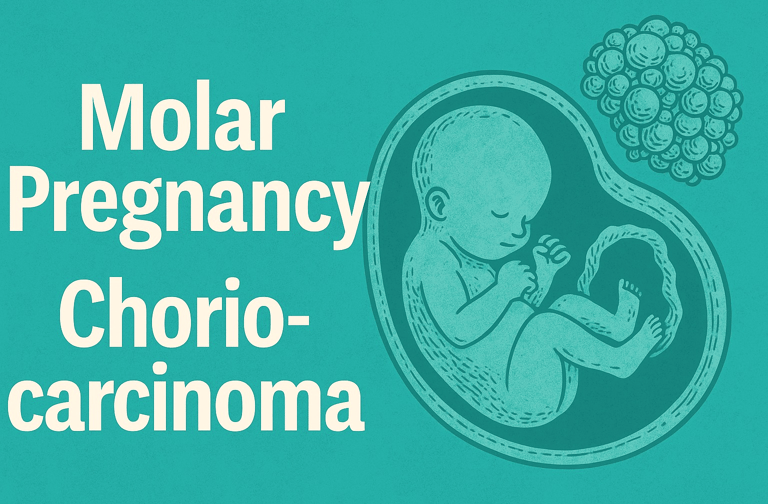Stay updated on what is trending in health. Discover tips and resources for a healthier, balanced life.
Molar Pregnancy and Choriocarcinoma: Understanding, Coping, and Moving Forward
Learn about molar pregnancy and choriocarcinoma. Discover symptoms, treatment, how to cope with the emotional effects, and recovery tips for a healthy future.
DISEASES AND CONDITIONS
Dr. S. Ali
8/12/20254 min read


When we think about pregnancy, the image in our minds is usually joyful — baby showers, ultrasound pictures, and excited planning for the future. But pregnancy doesn’t always follow the expected path. Sometimes, unexpected medical complications occur. One such rare but important condition is molar pregnancy, which in rare cases can lead to a type of cancer called choriocarcinoma.
While these terms sound frightening, the good news is that with early diagnosis and treatment, outcomes are usually excellent. In this article, we’ll break down what these conditions are, how they are treated, and what you can do if you or someone you love is affected.
What Exactly Is a Molar Pregnancy?
A molar pregnancy happens when an error occurs during fertilization, leading to the growth of abnormal tissue in the uterus instead of a healthy embryo and placenta. It’s part of a group of conditions called gestational trophoblastic disease (GTD) — disorders involving abnormal growth of placental tissue.
There are two main types:
Complete molar pregnancy
No fetus develops at all.
The uterus fills with abnormal placental tissue that resembles a cluster of grapes.
Partial molar pregnancy
Some fetal tissue develops alongside abnormal placental growth.
Unfortunately, this tissue is not viable and cannot result in a healthy baby.
In both cases, the pregnancy cannot continue and will require termination of pregnancy for the mother’s safety.
Why Does It Happen?
Molar pregnancies occur because of genetic errors during fertilization. For example:
In a complete molar pregnancy, an “empty” egg (with no maternal DNA) is fertilized by one or two sperm.
In a partial molar pregnancy, a normal egg is fertilized by two sperm, leading to too much genetic material.
The exact cause is still under study, but certain factors increase risk:
Maternal age under 20 or over 40
History of molar pregnancy
Certain dietary deficiencies (low carotene or vitamin A intake)
Symptoms You Should Know
Molar pregnancy often presents early in pregnancy with:
Vaginal bleeding
Severe nausea and vomiting
Uterus larger than expected for gestational age
No fetal heartbeat
Passing grape-like cysts from the vagina
Sometimes, symptoms can be mistaken for other pregnancy complications like chorioamnionitis (infection of the amniotic sac and fluid), but these are different conditions with different causes.
Diagnosis
Your healthcare provider will likely suspect a molar pregnancy if:
Ultrasound shows an unusual “snowstorm” pattern with no viable fetus
Blood tests reveal abnormally high hCG (human chorionic gonadotropin) levels
Treatment: What Happens Next
Once diagnosed, the abnormal tissue needs to be removed. The most common treatment is:
Dilation and curettage (D&C) — a surgical procedure to clear the uterus.
After the termination of pregnancy, you will have:
Weekly hCG blood tests until levels return to normal
Monthly monitoring for several months afterward
This follow-up is essential to ensure no molar tissue remains.
When Molar Pregnancy Leads to Choriocarcinoma
In about 2–3% of complete molar pregnancies, abnormal cells become cancerous — leading to choriocarcinoma.
What is it?
Choriocarcinoma is a rare but highly aggressive cancer that can develop after:
Molar pregnancy
Miscarriage
Termination of pregnancy
Even full-term delivery (rarely)
It can spread to the lungs, liver, brain, and other organs — but here’s the good news: it responds extremely well to treatment.
Symptoms of Choriocarcinoma
Persistent high hCG after pregnancy
Vaginal bleeding weeks or months later
Cough or shortness of breath (if spread to lungs)
Headaches or neurological symptoms (if spread to brain)
Treatment and Prognosis
The main treatment is chemotherapy.
Sometimes, surgery (like hysterectomy) is considered, but chemo alone is often enough.
Prognosis is excellent:
Cure rates approach 100% in early cases
Even in advanced cases, survival rates are very high
Vaccine Protection and Immune System
While no vaccine prevents molar pregnancy, maintaining overall reproductive health — including vaccination against infections like HPV — supports long-term uterine and cervical well-being. This is important because infections or chronic inflammation (such as from chorioamnionitis in other pregnancies) can complicate recovery from any reproductive condition.
Myths and Misconceptions
“It’s because of something I did wrong.”
False. Molar pregnancy is a genetic accident, not caused by diet, exercise, or activity.
“It means I can’t have children.”
False. Most people go on to have healthy pregnancies later.
“Choriocarcinoma means a poor prognosis.”
False. It’s one of the most treatable cancers.
Emotional Impact
Experiencing a molar pregnancy or choriocarcinoma can be emotionally draining. The sudden loss of pregnancy and the shock of a cancer diagnosis — even a highly treatable one — can lead to grief, anxiety, and depression.
Seeking support is crucial:
Talk to a counselor or therapist
Join online or in-person support groups
Lean on friends and family for emotional and practical help
Public Health Perspective
From a broader perspective, molar pregnancy and choriocarcinoma are rare, but their management showcases the importance of:
Accessible reproductive health care
Accurate diagnosis tools in early pregnancy
Follow-up systems to monitor hCG and detect complications
Education so women recognize abnormal symptoms early
Public health programs can:
Train healthcare providers in rural areas
Provide affordable pregnancy ultrasounds
Educate the public on the signs of pregnancy complications
Prevention and Next Steps
You can’t prevent molar pregnancy, but you can reduce complications by:
Getting early prenatal care in every pregnancy
Reporting abnormal symptoms quickly
Following your doctor’s post-treatment monitoring schedule
If you’ve had a molar pregnancy:
Avoid pregnancy until your doctor clears you (often 6–12 months)
Use reliable contraception during the monitoring period
The Bottom Line
Molar pregnancy and choriocarcinoma are rare but serious.
The key is early detection, effective treatment, and consistent follow-up. With proper care, full recovery — and future healthy pregnancies — are entirely possible.
If you or someone you know is going through this, remember: knowledge is power, and medical advances have made these once-feared conditions very treatable.
Sources
· American Cancer Society
https://www.cancer.org/cancer/types/gestational-trophoblastic-disease.html
· Mayo Clinic
https://www.mayoclinic.org/diseases-conditions/molar-pregnancy/symptoms-causes/syc-20375175
· Cleveland Clinic
https://my.clevelandclinic.org/health/diseases/17898-molar-pregnancy
· Cancer Research UK
https://www.cancerresearchuk.org/about-cancer/gestational-trophoblastic-disease
· National Cancer Institute
https://www.cancer.gov/types/gestational-trophoblastic/hp/gestational-trophoblastic-treatment-pdq
· MedlinePlus
https://medlineplus.gov/ency/article/001594.htm
· Johns Hopkins Medicine
https://www.hopkinsmedicine.org/health/conditions-and-diseases/gestational-trophoblastic-disease
Pulse Your Health
Empowering you to achieve your health goals.
Contact
© 2025. All rights reserved.
Disclaimer: The content on this website is for informational purposes only and is not medical advice. Always seek the advice of your physician or other suitably qualified healthcare professional for diagnosis, treatment and your health related needs.
